Literally “chui” means to “hit”, while “wan” means “ball” in Chinese. Therefore, Chuiwan means “to hit a ball” and is a type of ball game in ancient China. According to the order of ancient Chinese dynasties of Tang, Song, Yuan, Ming and Qing, Chuiwan in the Yuan Dynasty showed strong connections with the Tang Dynasty and Song Dynasty. It was prevalent during the Song, Jin and Yuan periods. As per the historical documents, Chuiwan players included not only emperors and ministers, but also people from all walks of the society. All of them indulged in this game tirelessly.
Tang Dynasty
Historical recordings showed that Chuiwan had close relationship with ball games in the Tang Dynasty.
The “polo” competitions in the Tang Dynasty were deemed unsuitable for women as the players had to ride on horses and that the games were quite intense. As a result, Budaqiu was invented for them: the women had only to run and swing the sticks (clubs) and see who would hit the ball the furthest.
Game rules: The players were divided into two opposing teams. The one that drove the ball into the opponents’ goal was the winner. The main players of Budaqiu were ladies from the imperial court. There was a line in the thirteenth poem of Poems of Palaces that went, “In the Hanshi Festival, ladies in the imperial court played Budaqiu,” which refers to the game of Budaqiu in the Tang Dynasty.
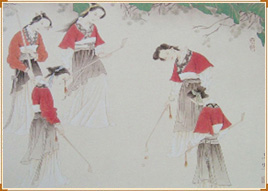
- Budaqiu is also called Buda and Buji, both of which mean striking balls on foot in Chinese language. It was recorded that “other than not riding horses, Budaqiu is similar to today’s polo.” The Poem of Playing A Ball Game on Horseback written by Yu Xuanji, a female poet in the Tang Dynasty, was printed in volume No. 840 of the Complete Poems of the Tang Dynasty, which includes the vivid description of the ball which was played in the game of Budaqiu, “Hard, round and smooth like a meteor, the ball was pursued and struck by a group of players. They would dribble when unobstructed, and would hook and hold the ball when blocked. They would keep the stick (club) with them for a long stretch, but feared that they would not be able to strike the goal. After all, getting the ball into the goal is the essence of the game. May you achieve the very best result.” These lines described the game of Budaqiu played by men vividly. In the Tang Dynasty, Budaqiu was very popular among both men and women in the imperial courts. According to the records of the book entitled Beimeng Suoyan, which means dreams and trivial affairs of the north, Emperor Xizong of the Tang Dynasty was good at Budaqiu. Until the late Qing Dynasty, this game was still being played by the commoners.
Song Dynasty
Budaqiu had developed into a new type of ball games in the Song Dynasty.
Game rules: The ball is struck with a stick (club), and a win is scored by hitting the ball into a hole on the ground. The rule of “winning by sending the ball into the goal of the opponents’ side” in the Tang Dynasty had been changed to “winning by hitting the ball into the hole on the ground.” In the Song Dynasty, Budaqiu had become a large-scale ball game which was hosted personally by the emperor. According the records of The Etiquette Part of the Song History, in March of every year, Emperor Taizong of the Song Dynasty would personally host the opening ceremony, and then organize the officials and artists to take part in the game.
Song Dynasty Album depicts chuiwan played by several children, This picture is regarded as a strong piece of evidence that Chuiwan was played among commoners in the Song Dynasty.
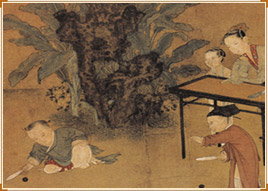
-
Striking a Ball in the Shade of Banana Trees
Striking a Ball in the Shade of Banana Trees is a picture created in the Song Dynasty which depicts a ball game played by several children. It is now preserved in the Palace Museum in Beijing. The picture depicts a ball game played by a group of children in the courtyard of a noble family in the Southern Song Dynasty. On the picture, there is a signature of Su Hanchen, a famous painter at the beginning of the Southern Song Dynasty, which implies that it was created by Su. However, it was a fashion at that time that many paintings had been signed with the name of Su, but it was actually just an imposture. Therefore, today’s experts regard such paintings as works by anonymous artists. In the Striking a Ball in the Shade of Banana Trees, under the shade of some banana trees in a courtyard, a lady plays a game with three children. Two boys hold sticks (clubs) and strike the ball while facing each other, while the lady and a small girl watch attentively behind a desk. The postures and expressions of all the figures are depicted vividly, and their clothing looks magnificent. In the picture, all four figures focused their attention on the small ball which the boys were going to strike. This picture is regarded as a strong piece of evidence that Chuiwan was played among commoners in the Song Dynasty.
Jin Dynasty and Yuan Dynasty
The game of Budaqiu was called Chuiwan since the Jin Dynasty and Yuan Dynasty.
Wan Jing (Literally Ball Game-treatise) ----“Both Emperor Huizong of the Song Dynasty and Emperor Zhangzong of the Jin Dynasty were fascinated with the game of Chuiwan.”
There is a line in The Celebration and Appreciation of the Dragon Boat Festival, “Dare you complete with me in Chuiwan, archery and wushu?”
“The Mural Painting of Chuiwan in the Yuan Dynasty” is now preserved at the Water God Shrine of the Guangsheng Temple in Hongdong County, Shanxi Province which depicts the scene of Chuiwan at that time, and has thus become the most visual and complete evidence of the game.
Both Emperor Huizong and Emperor Zhangzong liked to “research on the experiences and skills of Chuiwan of the ancient people, and keep improving the game” in ordinary days. The emperors used sticks (clubs) ornamented with pure gold on the side and jade on the top. Such extravagance and luxury is unmatched by any high-end golf equipment today.

- Mural Painting of Chuiwan in the Yuan Dynasty
The Mural Painting of Chuiwan in the Yuan Dynasty is now preserved at the Water God Shrine of the Guangsheng Temple in Hongdong County, Shanxi Province. It depicts the scene of Chuiwan at that time, and has thus become the most visual and complete evidence of the game. In the mural painting, two men play the game on a flat ground under the bright cloudy sky among the trees and rocks. Clad in long red gowns, both men hold a short stick (club) each in the right hand. The one at the left bends down and is ready to strike a ball; the one at the right squats sideways and affixes his gaze at a ball hole in the front. Two attendants are holding a stick (club) each at a short distance away, the tops of which are spheres. The figure in the middle puts out his hand to point to the location of the ball hole for the striker at the left. The picture is regarded as a true reflection of the game of Chuiwan among commoners in the Yuan Dynasty.
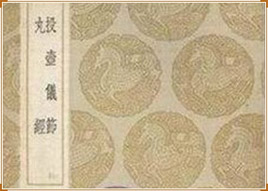
- Wan Jing
Wan Jing is the earliest book in the Yuan Dynasty, which is dedicated to the game of Chuiwan. It is pity that the author is untraceable now. The book’s table of content consists of thirty-two chapters that recount the development of Chuiwan, its playing field, equipment, competition rules as well as different kinds of striking methods and strategies. It emphasizes particularly on the ethics of sports activities, and the book is thus a rare and precious historical material. From Chuiwan’s competition rules to the gist of striking as well as from the making of the stick (club) to the maintenance of the field, the extent of the professionalism and details of the game is just as good as the modern sport that is golf.
In golf, a tee box is installed for serving a ball for each hole; in Chuiwan, a striking base is established before striking the ball. When striking a ball in Chuiwan, the strokes are divided into the first stroke, second stroke and third stroke. The first stroke must set the ball at the base before striking, and “the last place where the ball drops” shall be the new striking point of the next stroke. Other than the difference in the name, the entire game model of Chuiwan is almost the replication of golf.
Ming Dynasty
Chuiwan was prevalent mainly in urban areas, and its recreational value is even more apparent.
In the Wanli Period of the Ming Dynasty, Zhou Lijing reprinted Wan Jing, in the postscript of which the editor said, “I found when I toured around towns and cities in my post-adolescent stage that many people were fascinated with the game of Chuiwan.” With the fall of the Ming Dynasty, Chuiwan, like football and polo, was gradually suspended when the people were prohibited from practicing martial arts. At last, the game was lost.
The Picture of Emperor Xuanzong of the Ming Dynasty Seeking for Pleasure is now preserved at the Palace Museum in Beijing. The painting depicts Emperor Xuanzong as looking happy while playing Chuiwan.
The Picture of Beautiful Ladies Playing Chuiwanwas painted by Du Jin, a painter in the Ming Dynasty. Both the works mentioned above deliver a message that Chuiwan was very popular among royal families, officials and scholars as a classy recreational sports activity.
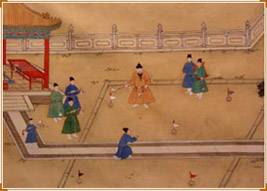
- Part of The Picture of Emperor Xuanzong of the Ming Dynasty Seeking for Pleasure
The ostentation and extravagance of Emperor Xunzong, the figure in the picture who is swinging the stick (club), playing a game on the field in his capacity would leave today’s sporting stars speechless. His sticks (clubs) are sorted one by one and stored in a specially-made game table with two attendants guarding them. Several assistants, who might be eunuchs, hold a stick (club) each and await cautiously as their master changes his stick (club). On Emperor Xuanzong’s private court, the four large plots of grass are trimmed flat and proper, and they have a total of ten holes on them. Like the rules of today’s golf course that a flag is planted at every hole, each hole in the picture is also planted with a flag, each having a different color as an indication. There are many other ancient paintings in China which are similar to the Picture of Emperor Xuanzong of the Ming Dynasty Seeking for Pleasure. In these pictures, there are children and women who play the game. Obviously, people at that time all love to play Chuiwan, regardless of gender or status.
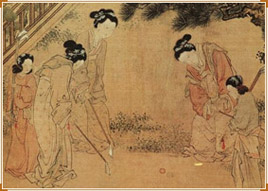
- The Picture of Beautiful Ladies Playing Chuiwan
It vividly depicts the scene of a “game of golf” being played by a group of ancient Chinese ladies: In the shade of pine trees or at the pond side, the beautiful ladies tread lightly and swing the sticks (clubs) elegantly, with two maids serving as caddies beside them. This demonstrates the comfort and affluence of the ladies’ lives, doing some exercises after meals. Therefore, an elegant sport such as Chuiwan was obviously the best choice.

Since the beginning of 2004, the Palace Museum and China Golf Association joined hands with experts and scholars of relevant institutions such as Peking University, Beijing Sport University, the Sports Department of the Northwest Normal University, China Central Academy of Fine Arts as well as Beijing Sports Museum to form a special subject research group on the sport of Chuiwan in China. On the basis of a large number of documents and materials, including Wan Jing, the treatise created in the Yuan Dynasty as well as the paintings of Emperor Xuanzong of the Ming Dynasty, Seeking for Pleasure and the Picture of Beautiful Ladies Playing Chuiwan, the group conducted in-depth researches and discussions on the culture of Chuiwan, and excavated and sorted out a full set of restored artistic works that are related to Chuiwan.
The Restored Chuiwan Collection and Its Miniature Collection
The Restored Chuiwan Collection Relevant and Its Miniature Collection is designed and created by the China Central Academy of Fine Arts under the supervision of the Palace Museum. A total of 99 sets and 2,008 sets of the aforesaid collection will be released for sales for the domestic and overseas markets respectively. The Restored Chuiwan Collection is made up of a stick (club), a ball, a box and a Deer Mountain stand.
For a detailed description, please refer to:http://sports.sina.com.cn/golf/2006-05-31/10002247116.shtml
Sports stamps
In December 1986, China released a set of stamps about ancient Chinese sports activities which consist of four pieces - archery, weiqi (go), Cuju and Chuiwan. All the four stamps were designed as per the stone reliefs of the Han Dynasty, which clearly indicates that the sport of Chuiwan had already taken shape during the Han Dynasty.
For a detailed description, please refer to:http://www.china.com.cn/aboutchina/zhuanti/zggdty/2008-07/14/content_16004846.htm 
Juan Antonio Samaranch, former president of the International Olympics Committee
During Beijing’s application to host the Olympic Games, Samaranch was awed to see the Chuiwan Picture, a mural painting of the Yuan Dynasty at the Water God Shrine of the Guangsheng Temple in Hongdong County, Shanxi Province, at the 5,000-year Sports History of China Exhibition, and said, “Wow! The Chinese had begun playing as early as during the Yuan Dynasty!”
For a detailed description, please refer to:http://news.sports.cn/others/others/2006-04-27/845426.html

Chuiwan-related articles displayed by the China Golf Association
On 26 April 2006, a symposium for the inspection, appreciation and discussion of restored artistic works related to Chuiwan, the so-called the “Origin of Modern Golf”, was held in the Great Hall of the People in Beijing. Guests of whom included Zhang Xiaoning, vice president of China Golf Association and secretary general, vice secretary general Li Yong, Chen Jian, representative of the Palace Museum as well as Dr. Cui Lequan, research fellow of China Sports Museum, were present at the symposium. In order to welcome the 2008 Beijing Olympic Games, uphold the spirit of the Humanistic Olympics as well as carry forward the broad and profound national sports culture of China, the Palace Museum and China Golf Association joined hands to set up the special subject research group on the sport of Chuiwan in ancient China, with the aim of conducting in-depth researches on the ancient Chuiwan culture.
For a detailed description, please refer to:
Sports Sina: http://sports.sina.com.cn/golf/2006-04-26/17102182684.shtml
The exhibits on display:http://golf.sina.com.cn/golf_channel/photo/28266/index.shtml 


